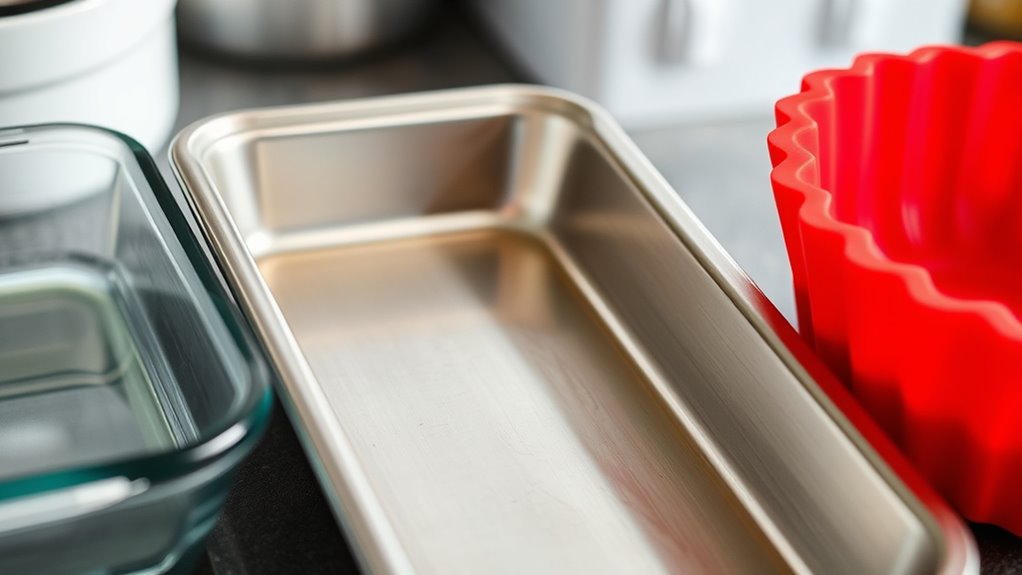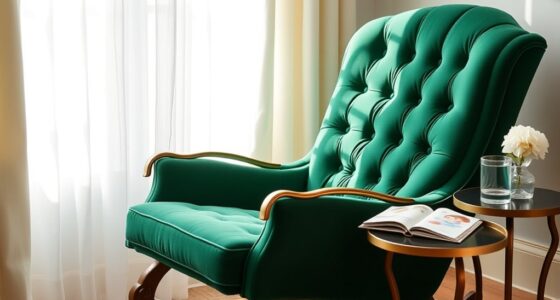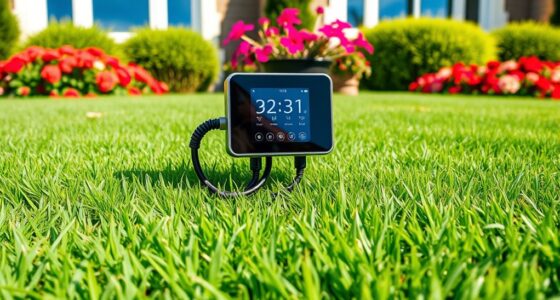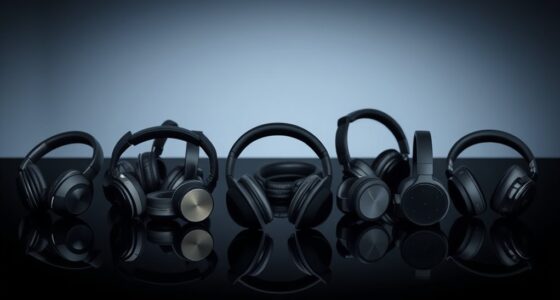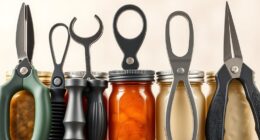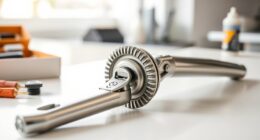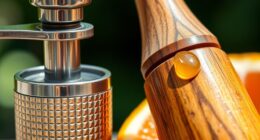Choosing between glass, metal, and silicone bakeware impacts your results. Metal pans, especially aluminum ones, conduct heat evenly and promote crisp, browned crusts, making them ideal for most baked goods. Glass and ceramic retain heat longer and offer gentle, even cooking but can cause lighter browning and require adjustments in temperature and time. Silicone pans are flexible and great for delicate treats but don’t brown much. To optimize your baking, understanding each material’s strengths and limitations can make all the difference for your next bake.
Key Takeaways
- Metal bakeware, especially aluminum, conducts heat quickly and evenly, promoting crisp crusts and browning.
- Glass bakeware heats slowly, retains heat longer, and often requires lower temperatures for even baking.
- Silicone pans are poor conductors, ideal for delicate baked goods but produce lighter textures and minimal browning.
- Metal pans are durable and versatile, while glass and ceramic are non-reactive but prone to thermal shock.
- Adjust oven temperature when using glass to prevent over-browning, and handle all bakeware carefully to ensure safety.
Characteristics of Metal Bakeware
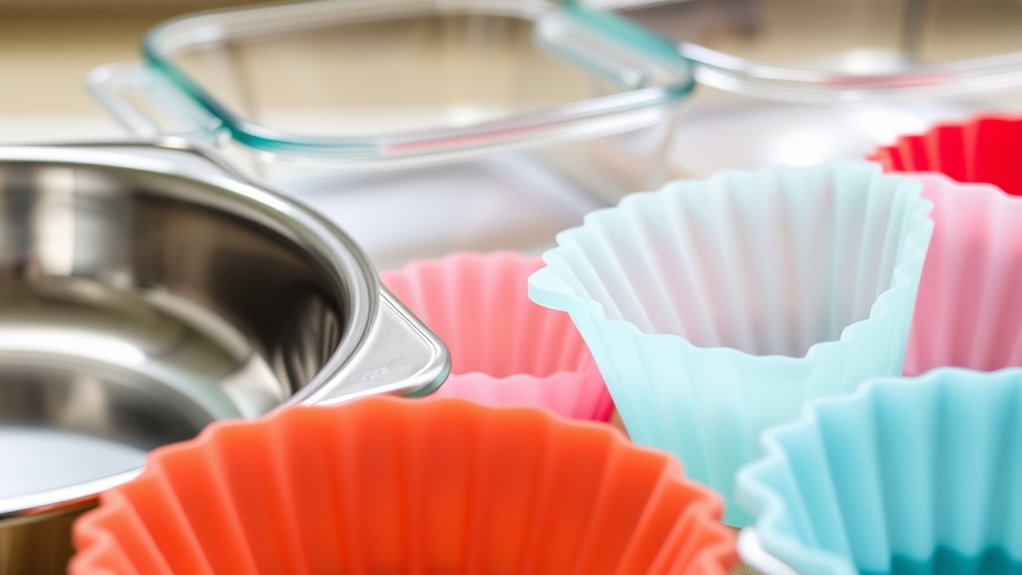
Metal bakeware, particularly aluminum, is popular because it conducts heat quickly and evenly, ensuring your baked goods brown uniformly. This pan material’s high thermal conductivity allows for efficient heat transfer, which promotes even baking and consistent results. Aluminum pans are lightweight, durable, and versatile, making them a favorite choice for many bakers. The type of metal affects heat distribution; dark metal pans absorb more heat, which can cause over-browning if not monitored carefully. Lighter or shiny metal pans reflect heat, helping achieve even coloration. Metal pans excel at browning crusts and developing rich textures, but you should handle them carefully to prevent scratching or warping. Overall, the heat transfer properties of metal bakeware make it ideal for a variety of baking tasks. Additionally, choosing the right metal type can influence the baking outcome, so understanding these properties helps in selecting the best bakeware for specific recipes.
Features of Glass and Ceramic Pans

Have you ever noticed how glass and ceramic pans heat differently from metal ones? These pans, such as glass and ceramic pans, conduct heat more slowly and unevenly, which can lead to longer baking times and lighter crusts. They retain heat longer after baking, helping keep food warm but increasing the risk of over-browning or burning if you’re not careful. Both materials are non-reactive, so they’re ideal for acidic dishes like citrus or tomato-based recipes without metallic flavor transfer. Additionally, their thermal properties mean that they can be more prone to cracking if exposed to sudden temperature changes, so handling them with care is essential. Their heat conduction properties also influence how quickly heat spreads through the pan, affecting baking results. Understanding heat conduction properties can help you optimize baking times and temperatures when using these materials. Using the appropriate care and handling techniques can extend the lifespan of your bakeware and ensure consistent results. Proper thermal shock resistance is crucial to prevent damage during rapid temperature changes. Just handle them carefully to prevent accidents and guarantee maximum results.
How Material Choices Affect Baking Results
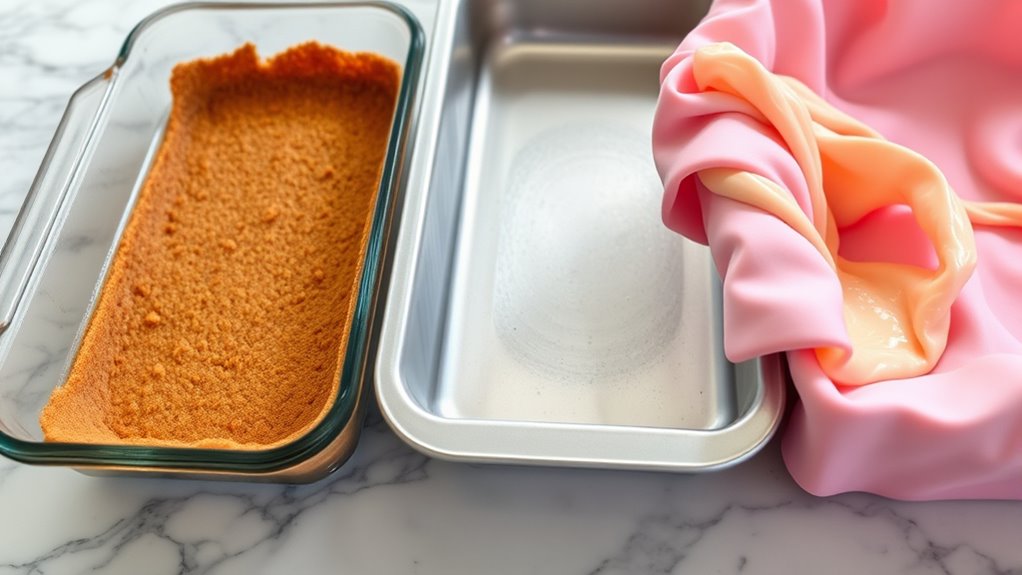
The material you choose for your bakeware directly impacts the appearance and texture of your baked goods. Metal pans, especially aluminum, excel in heat conduction, promoting even browning and crisp crusts, leading to better baking results. Dark-colored metal pans absorb more heat, causing faster browning and potential over-baking, while shiny metals produce more uniform coloration. Glass bakeware retains heat longer, resulting in lighter, less browned baked goods and often requiring a lower oven temperature and longer baking time. Silicone pans are poor conductors of heat, producing minimal crust browning and lighter textures, making them suitable for delicate items but not ideal for crust development. Overall, your choice of material properties considerably influences crust color, rise, and texture through heat conduction and retention. Additionally, appliance integration can enhance your baking experience by allowing remote monitoring and control of oven temperatures and timers.
Handling, Safety, and Maintenance Tips
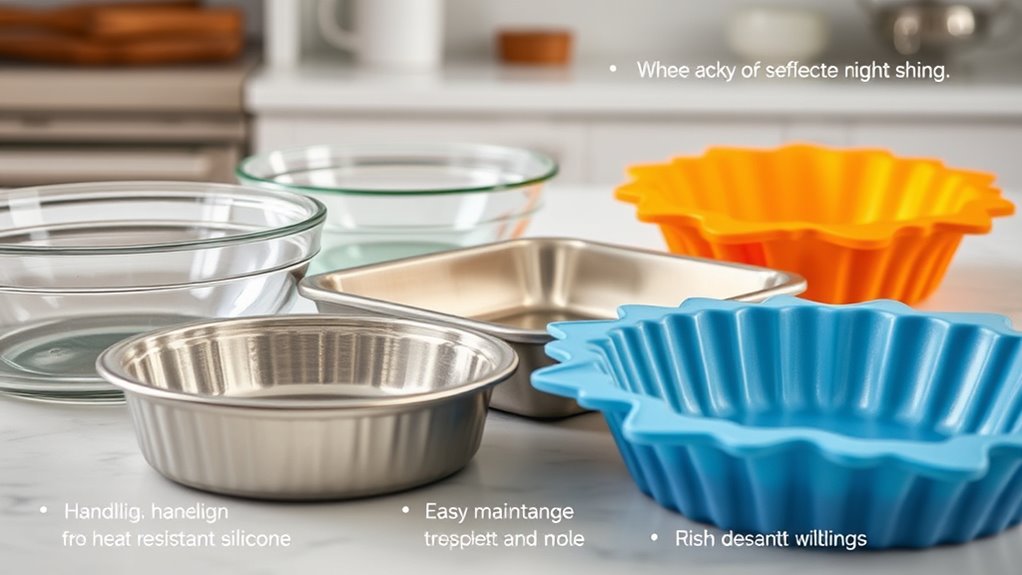
To guarantee your bakeware remains safe and in good condition, always handle hot items with oven mitts and avoid exposing glass or ceramic pans to sudden temperature changes, which can shatter. When using silicone or metal pans, inspect them regularly for tears, scratches, or signs of corrosion, and avoid using damaged pieces to maintain safety and non-stick performance. Clean metal pans promptly after baking to prevent staining, and steer clear of abrasive scrubbers on coated surfaces. Use non-metallic tools like silicone or wood to prevent scratches and preserve the integrity of non-stick coatings. Proper storage in a dry, secure place helps prevent breakage or cracking. Always wear oven mitts when handling hot bakeware to avoid burns and ensure safe, effective maintenance. Additionally, understanding sound vibrations and their influence on cellular health can inspire more mindful handling and care of your bakeware materials. Recognizing how material properties affect durability and safety can further enhance your baking experience. Moreover, being aware of safety standards and regulations related to bakeware can help prevent accidents and ensure long-term safety during use.
When to Use Each Material for Best Outcomes
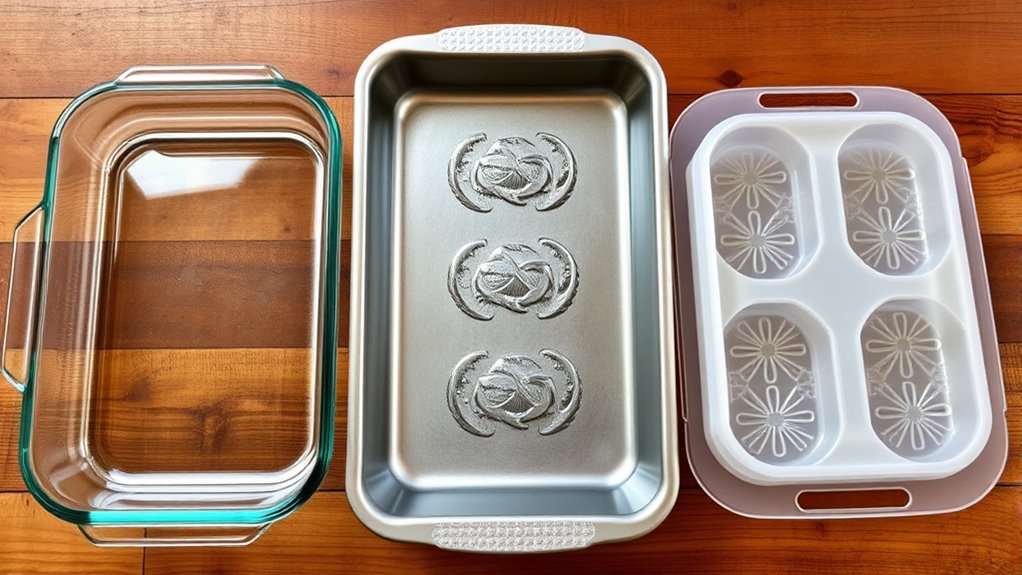
Choosing the right bakeware material can make a significant difference in your baking results. Use metal bakeware for even heat conduction, crisp crusts, and golden cookie browning. It’s ideal for baked goods needing high, consistent baking temperatures. Glass bakeware is best when visual monitoring matters or for dishes like casseroles that benefit from slow, even heat retention. Adjust oven temperature downward by about 25°F to prevent over-browning. Silicone pans excel with delicate baked goods such as light cakes and muffins, offering easy release but poor heat conduction. Additionally, understanding the contrast ratio of your oven or bakeware can help optimize baking outcomes by ensuring proper heat distribution. Recognizing the material properties of each bakeware type can further refine your baking process, leading to more consistent results, especially when considering heat transfer efficiency. Being aware of how different bakeware materials respond to heat can also assist in troubleshooting uneven baking issues.
Frequently Asked Questions
Is Silicone Bakeware Better Than Glass?
When you ask if silicone bakeware is better than glass, it depends on what you’re baking. Silicone is flexible, non-stick, and resistant to temperature shocks, making it easy to use for delicate baked goods. However, it doesn’t conduct heat well, leading to lighter, less browned results. If you prefer easy release and durability for light treats, silicone works well. But for even browning and crisp textures, glass often outperforms silicone.
What Is the Best Material for Bakeware?
When choosing the best bakeware, you need to take into account your baking goals. Metal pans, especially aluminum, heat quickly and promote even browning, ideal for crusty baked goods. Glass pans let you see inside and retain heat longer but may cause uneven baking. Silicone is flexible and great for delicate or non-traditional treats, though it doesn’t brown well. Pick the material that aligns with your desired results.
Is It Better to Bake in Silicone or Metal?
You might think silicone’s easy release makes it better, but for even baking and browning, metal wins. Metal conducts heat efficiently, giving you that perfect crust and golden finish. Silicone can require adjustments like lower temps or longer baking times. So, if you want consistent, professional results, especially for cookies and cakes, baking in metal is your best choice—you won’t be disappointed!
Is It Better to Use Glass or Metal for Baking?
When choosing between glass and metal for baking, you need to think about your goals. Metal pans heat quickly and promote even browning, giving you crisp crusts and tall baked goods. Glass pans, on the other hand, retain heat longer, so you might need to lower your oven temperature. Use metal if you want consistent browning, but choose glass for visual monitoring and slower, more even baking.
Conclusion
Choosing the right bakeware depends on your baking needs, preferences, and safety considerations. Metal heats quickly, giving crisp edges, while glass offers even baking and easy monitoring. Silicone is flexible and non-stick, great for certain recipes. Remember, “you are what you bake,” so pick the material that helps you make your best treats. With the right choice, your baking results will always shine—happy baking!
